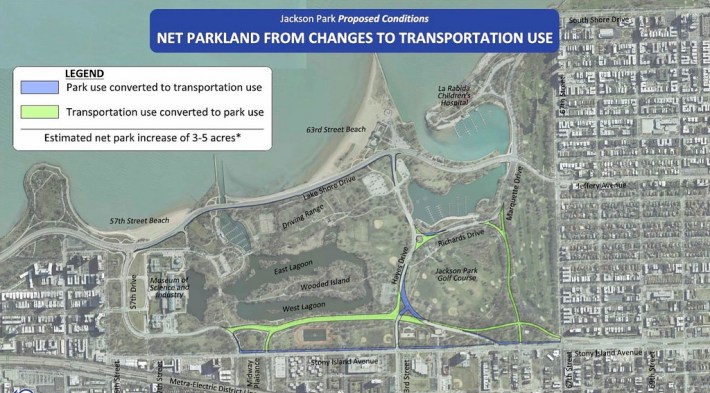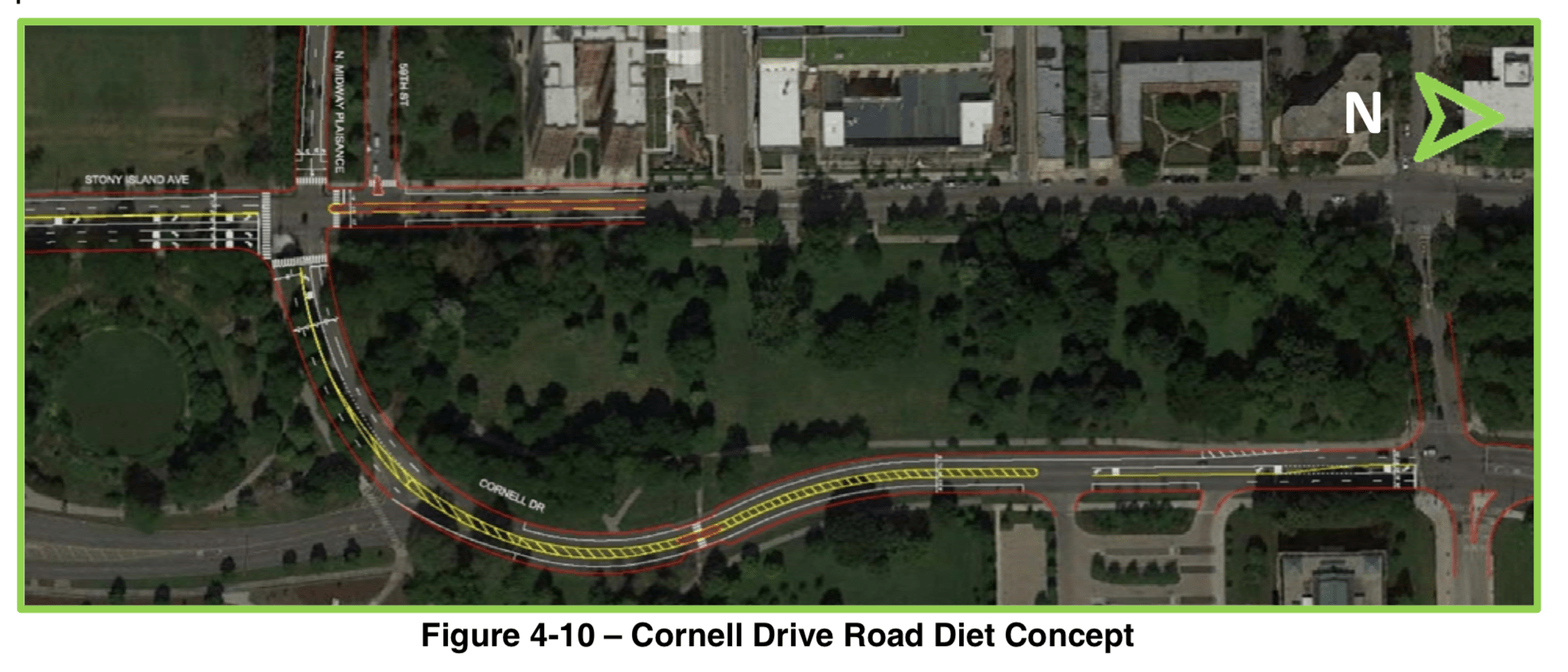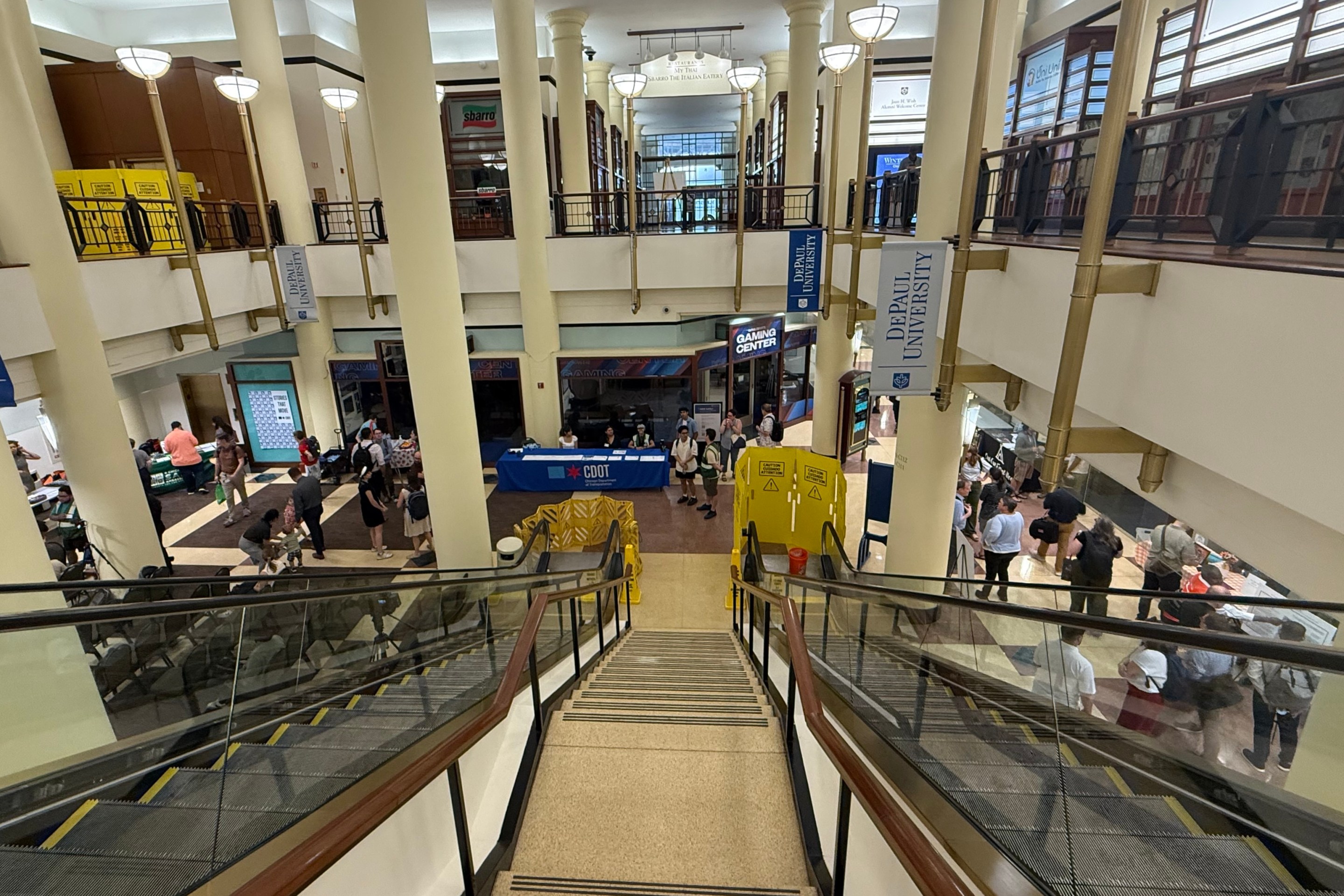Last week the city announced that transportation changes for the Obama Presidential Center in Jackson Park would cost roughly $175 million. The modifications would include pedestrianizing Cornell Drive on the east side of the campus, adding lanes to nearby stretches of Lake Shore Drive and Stony Island, stripping parking from a stretch of Hayes Drive in the park to create more travel lanes, building a few bike/pedestrian underpasses, and other elements.
On Tuesday the advocacy group Jackson Park Watch floated an alternative transportation proposal, arguing against the closure of Jackson Park and removal of parking from Hayes, and instead calling for a road diet on Cornell. While the group doesn’t have a problem with the Obama center being located in the park, they asserted that the $175 million price tag puts an “undue and unnecessary burden on taxpayers.”
JPW’s press release argued that the Chicago Department of Transportation’s plans for a road diet on Cornell between 57th and 59th, just north of the campus, would create a bottleneck for drivers and a hazard for people parking along this stretch. The group is also opposed to plans to route traffic between Lake Shore Drive and Stony Island on Hayes, which it says would create “a new congested and hazardous ‘S’ curve that bisects the park.”
JPW also claims that the parking along Hayes is heavily used by people accessing nearby playing fields, 63rd Street Beach, or Wooded Isle “and is not matched with adequate new parking options." Plans for the center currently include a 400-450-spot garage below the campus. “CDOT's parking analysis addresses only the needs of the OPC visitors and not those of other park users.”
The group also argued that road changes would “destroy key portions of the historic [Frederick Law-Olmsted] design of Jackson Park.
Instead JPW called for narrowing Cornell by the center and using other traffic calming strategies instead of pedestrianizing the road, a strategy that was recommended in the 1999-2000 Jackson Park/South Shore Framework Plan and brought up most recently in the 2016 proposal put forward by the Chicago Park District and Project 120, a public-private partnership working to improve South Side parks.
“There is no need to rush to decision,” JPW stated, noting that no changes can begin until federal reviews are completed, which won’t be until the end of the year.

There are some issues with the group’s logic on the need to maintain the road width on the northern stretch of Cornell. Generally, “four-to-three conversion” road diets, which swap four travel lanes for two lanes plus a turn lane, don’t increase congestion on stretches where the average number of car trips per day is less than 20,000, and they benefit all road users by discouraging speeding, organizing traffic, and facilitating left turns.
The CDOT traffic study for the area projects that, due to the widening of Lake Shore Drive and the closure of Cornell Drive south of 57th Drive, many drivers will be diverted from the open segment of Cornell and instead use LSD to go south. Therefore, there will be a drastic reduction of vehicles on 57th Drive, putting the number of cars on Cornell below 20,000 cars per day.
On Tuesday evening Barack Obama made a final pitch for the Jackson Park at a public meeting at McCormick Place. Members of JPW attended the hearing with a large poster of the current CDOT plan and passed out flyers asking for consideration of their alternative proposal.
CDOT spokesman Mike Claffey was quoted in a Chicago Tribune write-up of the meeting as saying the transportation plan addresses “long-standing traffic safety needs” around Jackson Park. He added that the department plans to widen Lake Shore Drive and Stony Island before the portion of Cornell is pedestrianized to prevent traffic jams.
However, widening those two roads will bring about new or increase existing and longstanding problems associated with bigger roads: Speeding and their subsequent crashes and death. Additionally, Stony Island is a residential street and its widening will make it harder and more dangerous for people to walk across it or bike along it.
The city’s approach ignores the phenomenon of "traffic evaporation" – when road capacity is decreased, some drivers respond by avoiding unnecessary trips or switching to other modes. So if we closed Cornell before or without adding capacity elsewhere, it’s likely many of the current trips would disappear, especially if CTA and Metra service were increased.
For better or worse, it looks like the city won’t have a problem funding the $175 million traffic plan. A spokesman for Governor Bruce Rauner told the Tribune that Rauner is “open to working with the general assembly on options” to help pay for the road expansions.






